Why Do Birds Flock Together in Winter?
Updated: Sep. 26, 2022
Discover why some birds flock together with other species during winter and learn how to spot mixed flock behavior for yourself.
Our editors and experts handpick every product we feature. We may earn a commission from your purchases.
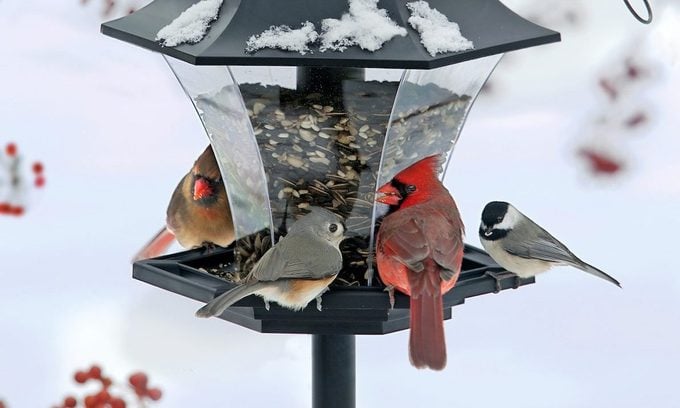
It’s not uncommon for still, silent winter landscapes to be suddenly disrupted by distant birdcalls. Within moments, half a dozen kinds of birds appear, flitting among tree branches, climbing up trunks, hanging upside down from twigs. For just a few minutes, the birds bring life to the area with colors, sounds and movement. Then they all fly away together. These mixed flocks of birds are one of winter’s special features. If you’re aware of the activity, you may be able to observe them practically anywhere in North America, and possibly in your own backyard.
Check out the 12 top tips for feeding birds in winter.
Birds Flock for Safety in Numbers
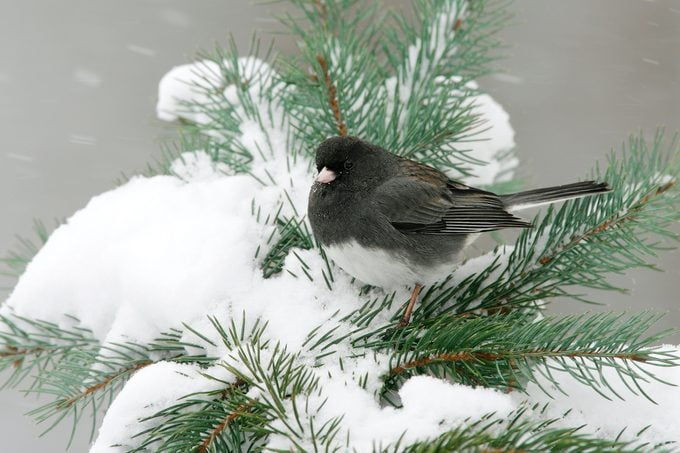
So why do we see these mixed flocks? It’s probably not just because birds enjoy one another’s company. For many, there’s a good reason for flocking: It’s safer than traveling alone. Searching for food out in the wild takes lots of concentration, and it’s hard to look for seeds or berries and watch for danger at the same time. With more birds in the flock, there’s a better chance that a swooping hawk or prowling cat will be spotted while there’s still time to sound the alarm and make a getaway.
Learn how to help birds in cold winter weather.
Chickadees Are Leaders of the Pack
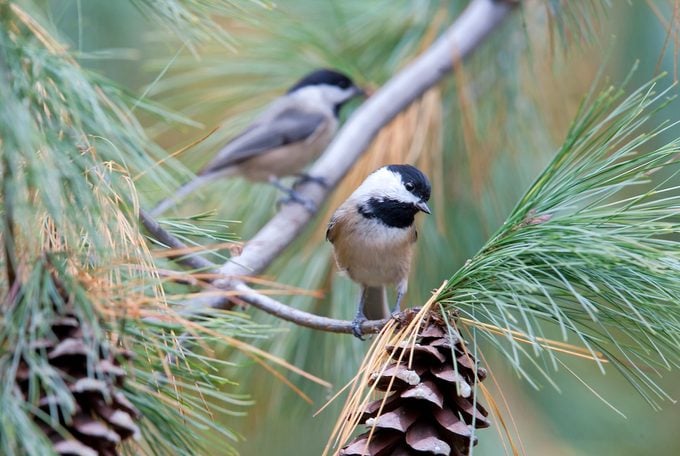
When you see a mixed flock moving through the trees, it may seem as if they’re all acting independently. But there are definite leaders and followers.
In treetop flocks, the leaders are usually chickadees. These busy, acrobatic little birds live in pairs or family groups during the summer, but in winter they gather in groups of a dozen or more. These flocks stick together throughout the cold months. As they make a regular circuit through the woods, other small birds fall in with them, following the lead of the chickadees—nuthatches, brown creepers, titmice, kinglets, downy woodpeckers and yellow-rumped warblers among them. These birds are clued in to the voices of their chickadee leaders, and when they hear an alarm note, they immediately look around for danger.
North America has several species of chickadees in different regions—including black-capped chickadees across the Northern states and Canada, Carolina chickadees in the Southeast, mountain chickadees in the Rockies and chestnut-backed chickadees in the Pacific Northwest—but they all serve as flock leaders in their own areas.
Zone Defense
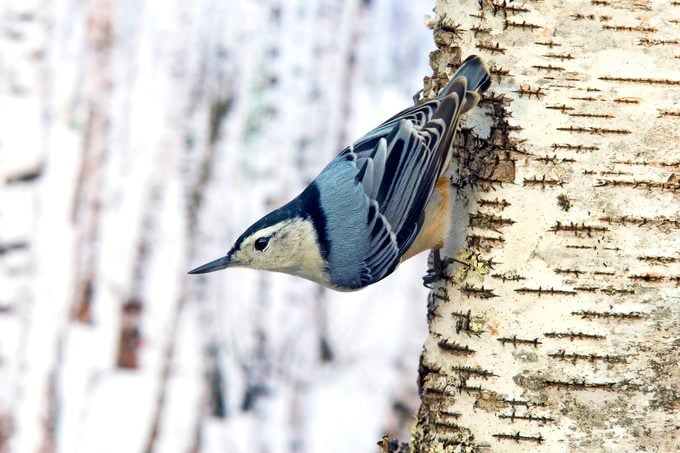
Active and alert, chickadees may be quicker to spot danger than the other birds that flock with them. For example, brown creepers, creeping up trees with their faces close to the bark, can’t be scanning in all directions as easily as a chickadee can.
The followers may not help the chickadees much, but they don’t do any harm, either. They usually aren’t competing for the same food, because they all seek nutrition in different ways. Woodpeckers, nuthatches and creepers examine the bark of trunks and large limbs, with the nuthatches often going down trees headfirst. Kinglets may hover under the tips of twigs, while titmice often hang upside down from heavier branches. So several kinds of birds can forage in the same tree without any direct competition.
It might seem as if the same birds are traveling with the chickadees all day, but that isn’t necessarily so. Some of these birds have their own winter territories, and they’ll stay with the flock only while it travels through their own corner of the woods. A white-breasted nuthatch, for instance, will follow right along with the chickadees until they come to the edge of its territory—then it will drop out, and another nuthatch from the neighboring territory will take its place in the flock.
See 7 types of finch birds to look for in winter.
Birds That Flock at the Feeder
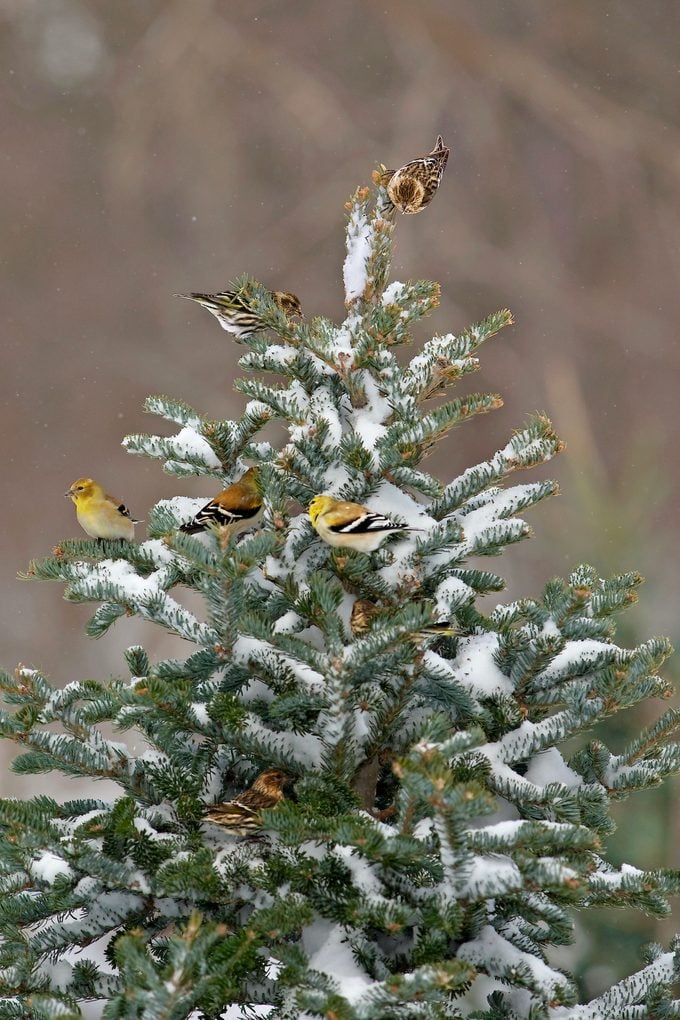
These winter flocks like to keep moving. Instinct tells them to travel within their home range so that they don’t use up all the food in any one spot. So even if you have a backyard filled with bountiful bird feeders, a flock is likely to arrive, stay for a short while and then move on. Don’t worry, though: It will be back, perhaps several times a day.
Treetop flocks led by chickadees represent only one kind of mixed winter flock. There are also mixed flocks of seed-eating birds that live close to the ground, often including dark-eyed juncos, American tree sparrows, white-throated sparrows, white-crowned sparrows and others. Another type of winter flock may include goldfinches, pine siskins and redpolls.
Keep an eye out for these winter flocks, either out in the woods or among the birds that visit your yard. When you spot one of these mixed gatherings, watch to see how the different species interact, and see if you can figure out which birds are the leaders and which are the followers. You’ll find that these diverse flocks add variety and excitement to your winter birding.
These busy, acrobatic little birds live in pairs or family groups during the summer, but in winter they gather in groups of a dozen or more.
Try these whimsical winter bird feeders.
4 Tips to Attract Mixed Flocks in Winter
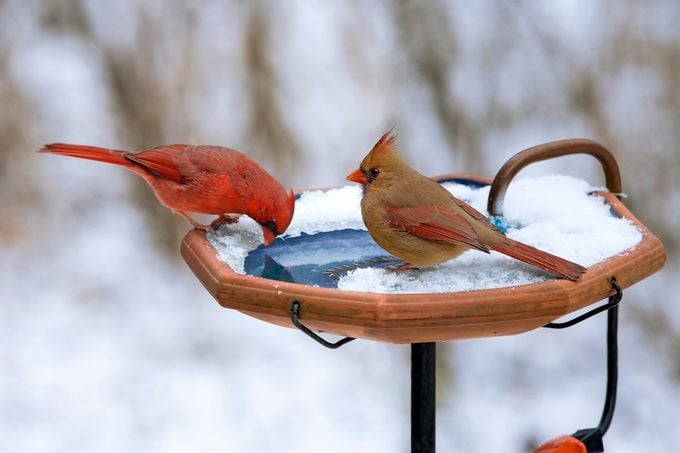
- Provide cover. Birds seek protection from predators and from extreme weather. Pine, cedar and spruce are great options in all seasons, but especially in winter. Winter visitors will also appreciate brush piles you can make out of fallen limbs and branches.
- Serve good eats. Black-oil sunflower seed, peanuts and suet provide important nutrients in winter. For some birds in mixed flocks, berries are also important. Some of our backyard favorites are serviceberry, dogwood, juniper, wild grape and viburnum.
- Put out ground feeders. Some winter flocks include juncos and native sparrows, which prefer to forage on or near the ground. A low tray-style feeder is best, but in a pinch you can sprinkle seed directly on the ground or on packed snow.
- Add fresh water. In areas with wintry weather, open water can be hard to find. Winter flocks are much more likely to visit a backyard with fresh water. Keep the water clean, and think about adding a birdbath heater.
Do Different Species of Birds Travel Together?
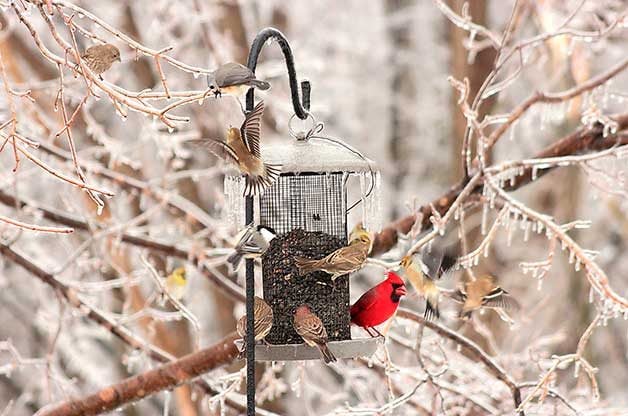
Question: Several birds show up at my feeders and bath at the same time. A chickadee arrives, followed by a titmouse, nuthatch, woodpecker and then sparrows. Do they travel like that all the time? —Jim Campbell of Lincoln, Rhode Islands
Kenn and Kimberly: You have fine powers of observation! That’s a good behavior description of these mixed flocks throughout the northeastern states. From late summer to early spring, when they’re not actively nesting and raising young, chickadees travel in flocks of up to a dozen or more. Other small birds, such as nuthatches, tufted titmice, and downy woodpeckers, follow along with them. They keep moving during the day, making regular circuits of bird feeders and nature food sources within the range of the chickadee flock, often coming around several times per day to visit feeders again.
Next, discover 20 birds to look for in the snowy season.
